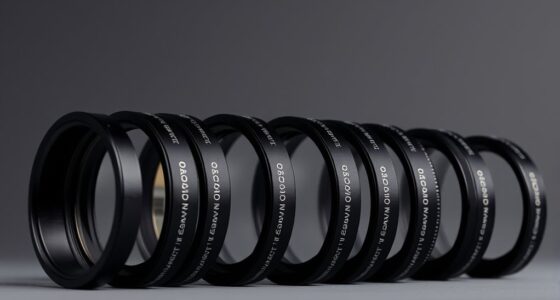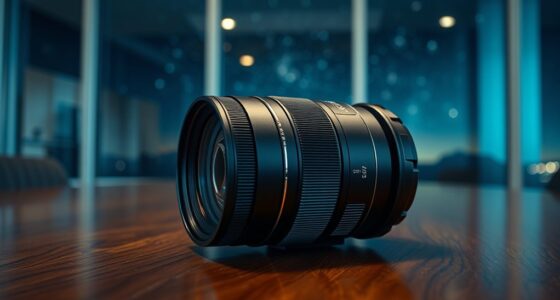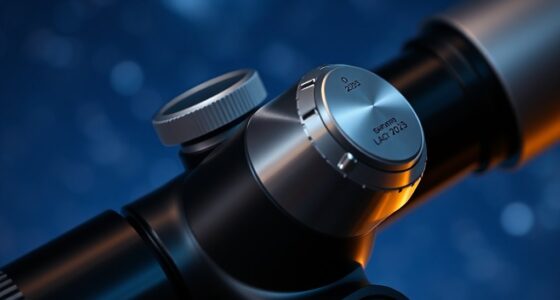If you’re looking for the top apochromatic refractors for widefield astronomy in 2025, I recommend the SVBONY SV503 for its large 102mm ED lens and excellent image quality, the Sky-Watcher Evolux 82ED for its compact design and premium ED doublet glass, and the SVBONY SV503 Refractor Kit which offers great versatility. These models excel in optical performance, portability, and features that suit widefield imaging. If you continue exploring, you’ll uncover even more details to help you choose the best fit.
Key Takeaways
- Prioritize models with high-quality ED or APO glass, such as S-FPL51, for minimal chromatic aberration in widefield views.
- Opt for refractors with fast focal ratios (f/4 to f/6) to maximize brightness and field of view for astrophotography.
- Consider portability, durable build, and features like dual-speed focusers and retractable dew shields for ease of use.
- Look for models offering broad fields of view, short focal lengths, and compatibility with accessories like reducers and flatteners.
- Evaluate the balance of optical performance, build quality, and value to select the best refractors for widefield astronomy in 2025.
SVBONY SV503 Refractor Telescope
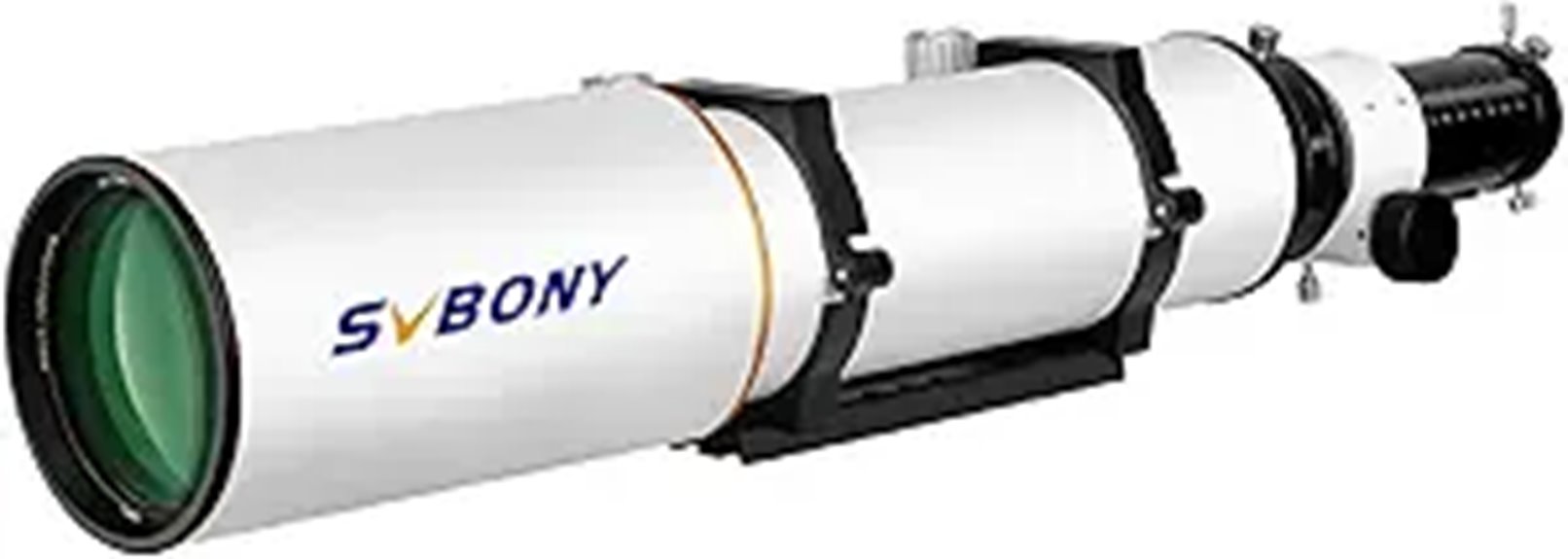
If you’re looking for a high-quality refractor that balances excellent optical performance with affordability, the SVBONY SV503 Refractor Telescope is an ideal choice. It features a 102mm objective lens, f/7 focal ratio, and high-quality S-FPL51 ED glass that minimizes chromatic aberration, resulting in bright, sharp images. Its multi-layer coatings boost brightness and resolution, while the retractable dew shield helps prevent dew and stray light. The dual-speed focuser ensures precise adjustments, and the robust build provides durability. Perfect for astrophotography and visual use, this scope offers great value, especially for those wanting a portable, versatile instrument capable of capturing detailed deep-sky and planetary images.
Best For: amateur astronomers and astrophotographers seeking a portable, high-quality refractor telescope with excellent optical performance at an affordable price.
Pros:
- Excellent image clarity with minimal chromatic aberration due to high-quality S-FPL51 ED glass
- Smooth dual-speed rack-and-pinion focuser allows precise adjustments
- Durable build with features like retractable dew shield and moveable tube rings for portability
Cons:
- Initial focuser backlash may require minor adjustments
- No included storage case, which may affect transport convenience
- Slight chromatic aberration on very bright objects like the moon, typical for achromatic scopes
Sky-Watcher Evolux 82ED Doublet Apo Refractor Telescope
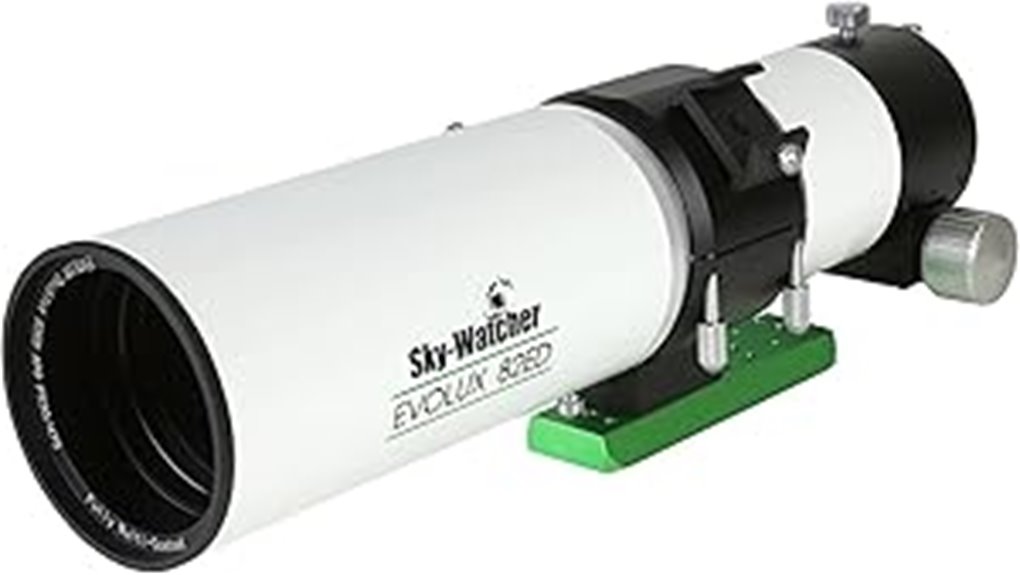
The Sky-Watcher Evolux 82ED Doublet Apo Refractor Telescope is an excellent choice for astrophotographers and amateur astronomers seeking a portable, budget-friendly instrument with advanced optics. Its lightweight, compact design makes it perfect for wide-field imaging and quick setups. The ED doublet lens with High-Transmission Coatings reduces false color and delivers sharp, contrast-rich images. However, some units may struggle with chromatic aberration and build quality feels somewhat cheap compared to premium models. Priced around $629, it offers good value for beginners and casual users, especially when paired with accessories like reducers or filters, though variability in manufacturing is a consideration.
Best For: amateur astronomers and astrophotographers seeking an affordable, portable refractor with advanced optics for wide-field imaging and casual observing.
Pros:
- Lightweight and compact, ideal for grab-and-go setups and travel
- Advanced ED doublet lens with coatings that reduce false color and improve contrast
- Good optical performance for visual use and astrophotography at an accessible price point
Cons:
- Build quality can feel cheap or lightweight compared to premium telescopes
- Some units may experience chromatic aberration or manufacturing inconsistencies
- Focus mechanism and accessories may lack durability or smoothness
SVBONY SV503 Refractor Telescope Kit

For serious amateur astronomers seeking high-quality images, the SVBONY SV503 Refractor Telescope Kit stands out with its large 102mm ED lens and fast F7 focal ratio. This combination delivers bright, sharp images of planets, galaxies, and nebulas. The included 0.8x focal reducer and field flattener make it ideal for full-frame astrophotography, enhancing illumination and detail. The dual-speed focuser and 360° rotation ensure precise adjustments, while compatibility with various finder scopes adds versatility. Its portable design, featuring a dedicated handle, makes setup easy for on-the-go observing. Overall, the SV503 is a robust, versatile choice for both visual and astrophotographic pursuits.
Best For: Amateur astronomers and astrophotographers seeking a high-quality, portable refractor telescope with excellent imaging capabilities.
Pros:
- Large 102mm ED lens provides bright, high-contrast images of celestial objects.
- Dual-speed focuser and 360° rotation allow for precise focusing and easy targeting.
- Compatible with various finder scopes and accessories, enhancing versatility and setup options.
Cons:
- May be relatively heavy and bulky for ultra-portable use without additional accessories.
- Requires careful calibration when using the focal reducer and field flattener for optimal images.
- Price point might be higher compared to smaller or less feature-rich beginner telescopes.
Factors to Consider When Choosing Apochromatic Refractor for Widefield

When selecting an apochromatic refractor for widefield viewing, I focus on optical quality and the type of glass used, since these affect image clarity. I also consider how well the scope controls chromatic aberration and whether the aperture size and focal length suit my widefield needs. Finally, I look at the build, portability, and focal speed to guarantee it’s practical for my observing sessions.
Optical Quality and Glass
Optical quality and glass selection are essential factors that directly influence the performance of an apochromatic refractor, especially for widefield observing. Using high-quality ED or APO glass, like S-FPL51, considerably reduces chromatic aberration and enhances image sharpness, contrast, and color fidelity. Superior glass minimizes false color fringes around bright objects, resulting in more accurate, pleasing images. The choice of glass and lens coatings also affects light transmission, brightness, and contrast—crucial for capturing fine details in astrophotography. Well-matched lens elements and high-transmission coatings ensure uniform focus across the wide field of view. Prioritizing optical quality and glass selection ensures you get the most out of your instrument, delivering crisp, vibrant images and a more enjoyable observing experience.
Chromatic Aberration Control
Have you ever noticed how bright stars or planets can display colorful fringes at the edges? That’s chromatic aberration, and controlling it is key when choosing an apochromatic refractor. Proper apochromats use ED or fluorite glass to minimize these color fringes across the visible spectrum. Achieving excellent correction involves precise lens spacing and matching glass types to reduce false color, especially at high magnifications. Many high-quality apochromats show minimal fringing on bright objects like planets and stars, often enhanced further with filters or accessories. To assess chromatic correction, I examine star images at the edge of the field, where CA is most noticeable. Advanced designs, such as triplet apochromats, generally provide better correction than doublets, though well-made doublets can still deliver impressive results.
Aperture Size and Field
Choosing the right apochromatic refractor for widefield imaging means paying close attention to aperture size and focal length. Larger apertures, like 80mm or more, gather more light, resulting in brighter images with greater detail. This enhances deep-sky object imaging, especially in widefield views. The focal length determines the field of view; shorter focal lengths, around 400-600mm, offer wider perspectives ideal for capturing large nebulae and star clusters. Combining a larger aperture with a shorter focal length creates a broad, bright view of the sky. Using focal reducers or flatteners further increases the field of view without changing the aperture. Balancing aperture size and focal length is key to optimizing both brightness and sky coverage for successful widefield astrophotography.
Focal Length and Speed
When selecting an apochromatic refractor for widefield imaging, focal length and speed are crucial factors that directly affect your results. Shorter focal lengths, around 400-600mm, offer wider fields of view, making them perfect for capturing large objects like nebulae and star clusters. Faster focal ratios, such as f/4 to f/6, enable shorter exposures and better imaging of deep-sky objects in widefield setups. However, slower ratios like f/7 and above provide higher image scale and detail, but require longer exposure times. The focal ratio influences brightness and resolution, with faster scopes delivering more luminous, expansive views. Striking the right balance between focal length and speed helps optimize both the field of view and image quality for your astrophotography goals.
Build and Portability
A lightweight and compact design makes an apochromatic refractor more portable, which is especially important for widefield astrophotography or visual observation on the go. A sturdy build with durable materials guarantees the telescope can handle frequent handling and outdoor conditions without damage. Moveable tube rings with handles make mounting, adjusting, and carrying the scope more convenient, saving time and effort. An extendable dew shield helps prevent dew buildup but adds length and weight, influencing portability considerations. Additionally, a solid mounting system, along with accessories like dovetails and carrying cases, greatly improves ease of transport and storage. These build features ensure your telescope remains reliable and manageable, whether you’re traveling to dark-sky sites or setting up quickly at home.
Focusing Precision and Ease
Focusing precision is essential for getting sharp, detailed images, especially in widefield astrophotography. Apochromatic refractors often have dual or triplet lens setups that allow for finer focus control, resulting in crisper images. Dual-speed rack-and-pinion focusers enable precise adjustments, helping me achieve critical focus with minimal backlash. The ability to rotate the focuser 360 degrees makes framing and focusing objects at different positions within the field quick and effortless. Fine focus markings and smooth operation allow me to recover focus rapidly after changing eyepieces or filters, boosting efficiency. High-quality focus mechanisms with stable locking features ensure my focus stays consistent, which is crucial for detailed imaging. Overall, focusing ease and accuracy are key for maximizing the performance of an apochromatic refractor.
Accessories Compatibility
Choosing an apochromatic refractor that supports a broad range of accessories is essential for versatile astrophotography and observing sessions. I look for a telescope with a mounting system compatible with common eyepieces and filters, like 2-inch or 1.25-inch options. It’s also important that the focuser can handle focal reducers, flatteners, and camera adapters, so I can customize my setup for widefield imaging. I check if the telescope includes or is compatible with finderscopes or guide scopes for precise navigation. A universal dovetail or mounting plate system matters, as it allows me to attach accessories from different brands easily. Finally, I verify if the optical design and internal threading support specialty accessories like ultra-wide-angle eyepieces or field flatteners for maximum widefield performance.
Price and Value
When evaluating apochromatic refractors for widefield astrophotography, price and value go hand in hand. Generally, higher-priced models offer superior optical quality, better build, and more features, providing long-term value. Budget-friendly options can perform well but often compromise on materials, coatings, or mechanical precision, impacting durability and image quality over time. When appraising value, consider key optical features like ED glass and multi-layer coatings, which help minimize chromatic aberration and produce sharp images. Extras such as reducers, finders, or dew shields add versatility and enhance overall worth. Comparing the scope’s cost against its performance, durability, and included accessories helps determine if it’s a good investment for both beginners and seasoned astronomers seeking the best balance of quality and price.
Frequently Asked Questions
How Do Apochromatic Refractors Compare to Other Telescope Types?
Apochromatic refractors outperform other telescope types in delivering sharp, color-free images with minimal chromatic aberration. I find them ideal for widefield astronomy because they provide stunning clarity and contrast across the entire field of view. Compared to achromatic refractors or reflectors, apochromats require less post-processing and offer a more enjoyable viewing experience. They’re my go-to choice when I want detailed, high-quality observations of the night sky.
What Is the Typical Lifespan of High-Quality Apochromatic Lenses?
High-quality apochromatic lenses usually last a lifetime if I take good care of them. They’re made from durable glass and premium coatings that resist scratches and environmental damage. I make sure to store them in a dry, dust-free environment and handle them gently. With proper maintenance, these lenses can serve me well for decades, making them a solid investment for my astronomy hobby.
Are There Specific Accessories Recommended for Widefield Astrophotography?
For widefield astrophotography, I recommend using a sturdy mount with precise tracking to keep your images sharp. A good star diagonal and a wide-field camera lens are essential for capturing expansive views. Also, consider filters like light pollution filters to enhance clarity. Finally, a reliable remote shutter or intervalometer helps avoid vibrations during long exposures. These accessories really improve your astrophotography experience and results.
How Does Temperature Affect Apochromatic Refractor Performance?
Temperature changes can substantially impact an apochromatic refractor’s performance. As it cools or heats up, the glass and metal components expand or contract, causing slight shifts in focus and potential image distortion. I always let my telescope reach ambient temperature before observing or shooting astrophotography. Using dew shields and heaters helps maintain stable conditions, ensuring sharp images and consistent performance during my sessions.
What Maintenance Is Required to Keep These Telescopes Optimal?
Ever wondered how to keep your telescope in top shape? I regularly clean the lenses with a soft brush and gentle lens cleaner, and I check for dust or moisture buildup. I also store it in a dry, dust-free environment and avoid rapid temperature changes. Regularly collimating and inspecting the focuser ensures peak performance. Proper maintenance not only prolongs your telescope’s life but also guarantees sharp, clear views every time you observe.
Conclusion
Choosing the right apochromatic refractor isn’t just about specs; it’s about finding a tool that sparks your passion. Whether you prefer the sleek simplicity of the SVBONY SV503 or the versatile Sky-Watcher Evolux 82ED, each offers unique advantages. Think of it like selecting a camera—sharp optics matter, but so does how it feels in your hands. Ultimately, it’s about blending precision with joy, making every stargazing session a memorable adventure.



